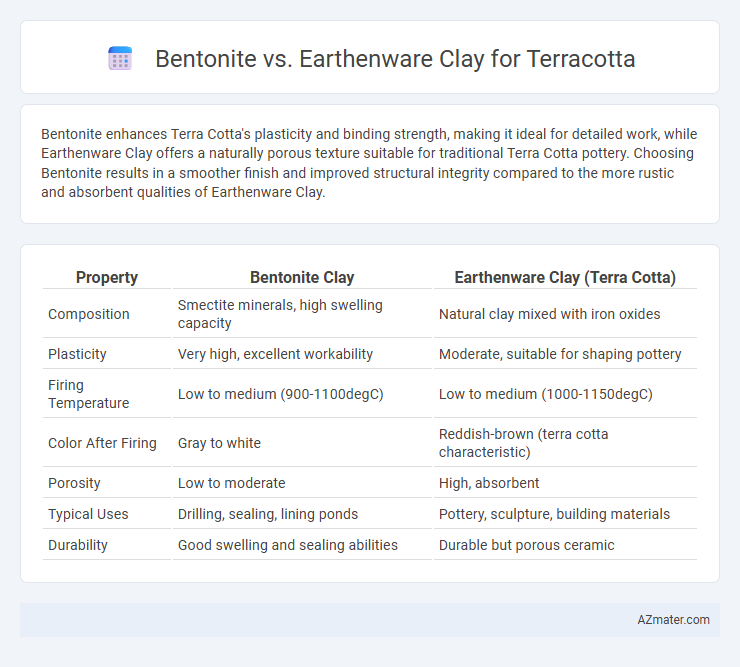Bentonite enhances Terra Cotta's plasticity and binding strength, making it ideal for detailed work, while Earthenware Clay offers a naturally porous texture suitable for traditional Terra Cotta pottery. Choosing Bentonite results in a smoother finish and improved structural integrity compared to the more rustic and absorbent qualities of Earthenware Clay.
Table of Comparison
| Property | Bentonite Clay | Earthenware Clay (Terra Cotta) |
|---|---|---|
| Composition | Smectite minerals, high swelling capacity | Natural clay mixed with iron oxides |
| Plasticity | Very high, excellent workability | Moderate, suitable for shaping pottery |
| Firing Temperature | Low to medium (900-1100degC) | Low to medium (1000-1150degC) |
| Color After Firing | Gray to white | Reddish-brown (terra cotta characteristic) |
| Porosity | Low to moderate | High, absorbent |
| Typical Uses | Drilling, sealing, lining ponds | Pottery, sculpture, building materials |
| Durability | Good swelling and sealing abilities | Durable but porous ceramic |
Introduction to Bentonite and Earthenware Clay
Bentonite is a naturally occurring clay known for its exceptional swelling properties and high plasticity, making it ideal for enhancing the workability and durability of terra cotta. Earthenware clay, characterized by its porous texture and lower firing temperature, is widely used in traditional terra cotta production to achieve a warm, rustic finish. Understanding the distinct mineral compositions and physical characteristics of bentonite and earthenware clay is essential for optimizing the quality and performance of terra cotta ceramics.
Composition and Mineral Content
Bentonite primarily consists of montmorillonite, a smectite group clay mineral rich in swelling properties and high cation exchange capacity, making it distinct in its absorption and plasticity. Earthenware clay for terra cotta contains a blend of kaolinite, illite, and varying amounts of quartz and feldspar, providing a coarser texture and lower plasticity compared to bentonite. The mineral composition of earthenware clay results in a porous and slightly less dense fired body, while bentonite's mineralogy contributes to a tighter, more plastic, and more cohesive raw material.
Physical Properties Comparison
Bentonite displays superior plasticity and swelling capacity compared to earthenware clay, making it ideal for molding intricate terra cotta shapes. Earthenware clay typically has coarser particles and lower plasticity, resulting in less shrinkage and higher porosity after firing. The density of bentonite ranges from 2.4 to 2.8 g/cm3, while earthenware clay is generally lighter, affecting the final strength and water absorption characteristics of terra cotta products.
Plasticity and Workability Differences
Bentonite exhibits significantly higher plasticity compared to earthenware clay, allowing for greater flexibility and ease of shaping in terra cotta applications. Its fine particle size and colloidal properties enhance workability, enabling smoother manipulation and reduced cracking during drying and firing. Earthenware clay, while naturally workable, tends to be coarser and less plastic, requiring careful moisture control to achieve similar malleability and structural integrity in finished pieces.
Firing Temperatures and Thermal Behavior
Bentonite enhances earthenware clay for terra cotta by improving plasticity and thermal shock resistance during firing, typically suited for lower temperatures around 1000degC to 1150degC. Earthenware clay, primarily composed of natural minerals like kaolinite and iron oxides, matures at similar low firing ranges but has less thermal shock tolerance than bentonite-infused bodies. The combination allows terra cotta to withstand expansion and contraction, reducing cracking and improving durability under thermal cycling conditions.
Color and Texture Variations
Bentonite clay offers a smooth, fine texture with a grayish color that darkens when fired, enhancing terra cotta's depth and durability. Earthenware clay typically features a coarser, grainier texture and ranges in color from warm red to orange, contributing to the classic rustic appearance of terra cotta pottery. The choice between bentonite and earthenware clay significantly affects the final color vibrancy and surface texture, influencing both aesthetic appeal and functional qualities of terra cotta pieces.
Water Absorption and Porosity
Bentonite exhibits high water absorption due to its fine particles and swelling capacity, enhancing plasticity but increasing porosity, which can affect the durability of terra cotta. Earthenware clay, with larger particle size and moderate porosity, absorbs less water, resulting in a sturdier, less permeable terra cotta product. The balance between Bentonite's water retention and Earthenware's porosity influences the terra cotta's final strength and susceptibility to moisture damage.
Strength and Durability
Bentonite enhances terra cotta strength by improving plasticity and binding properties, resulting in more durable and less porous finished pieces compared to standard earthenware clay. Earthenware clay, while traditional and easy to work with, tends to be more porous and less resistant to cracking and weathering under stress. The addition of bentonite creates a denser, more resilient terra cotta suitable for structural and decorative applications where longevity is crucial.
Applications in Terra Cotta Production
Bentonite enhances terra cotta production by improving plasticity and binding properties, allowing for finer detail and reduced cracking during firing. Earthenware clay, traditionally used in terra cotta, provides natural porosity and a warm, rustic finish ideal for sculptural and architectural applications. Combining bentonite with earthenware clay optimizes workability and durability in terra cotta products, meeting both aesthetic and structural requirements.
Environmental and Economic Considerations
Bentonite enhances the plasticity and durability of earthenware clay in terra cotta production, reducing the need for excessive firing and lowering energy consumption. Earthenware clay, abundant and locally sourced, offers cost-effective raw material availability but may require higher firing temperatures leading to increased energy use. Choosing bentonite-amended clay mixes can optimize environmental impact by minimizing carbon footprint and improve economic efficiency through reduced fuel costs in the kiln.

Infographic: Bentonite vs Earthenware Clay for Terra Cotta
 azmater.com
azmater.com